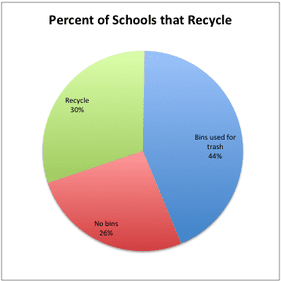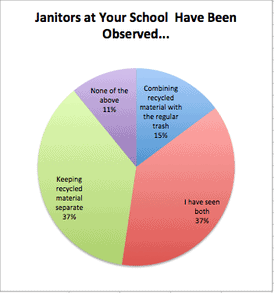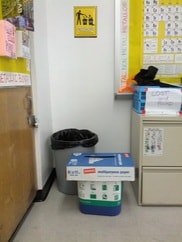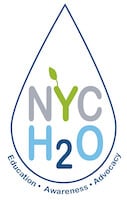April 3, 2013 by Matt Malina
New York City throws away a lot of trash: 3.2 million tons of it every year. That’s enough garbage to fill Yankee stadium 3 times over from the field to the top of the lights!
According to the NYC Department of Sanitation (DSNY) the city only recycles about 15% of residential waste. Schools are serviced by the same DSNY trucks and hence included with this statistic. The rest goes to landfills or is burned as fuel in ‘Waste to Energy’ plants like the Covanta facility in Newark, NJ. There is a lot of recycling to be done in NYC and NYC schools can help lead the way.
Sending trash to landfills costs the city $300 million a year because the landfills are located far away in states like Ohio, Pennsylvania, Upstate New York, South Carolina and Virginia. Recycling is more cost effective than landfilling. On average, it costs the city $92 per ton to send trash to landfills while it costs $75 per ton to recycle bottles and cans. Even better, the city is paid $20 per ton for the paper and cardboard that it recycles. All told the city netted $2 million from selling its paper in 2012.
But there is a lot of room to improve recycling and thereby save the city even more. Based on the DSNY statistic that residential recycling is 15% for the city as a whole, if residents recycled 30% they would divert 600,000 tons of trash from landfills and save the city an estimated $38 million per year.
Why don’t residents recycle more? Most residents were not taught to recycle when they were growing up and therefore haven’t developed good recycling habits. This is where schools can be a tremendous asset to the city. Students can be engaged and taught good lifelong practices.
According to NYC Department of Education (DOE) statistics, there are 1.1 million students on its roles. This represents a tremendous opportunity to teach good recycling habits to a 1 out of 8 people in our city.
Furthermore, according to DOE records requested through Freedom of Information Law (FOIL), public schools use 118 million Styrofoam trays and then throw them away every year. They are not recyclable. Hopefully the mayor’s plan to ban styrofoam in the city will end this practice.
In 2010, Local Law 41 was passed and mandated that schools recycle. It spelled out specific steps that must be implemented. Among the requirements: every classroom is required to have a paper recycling bin and every school must appoint a “Sustainability Coordinator,” who oversees recycling for the school.
However, according to a recent survey conducted by the educational nonprofit group NYC H2O, even after 3 years since the passage of the bill, 70% of public schools either do not have recycling bins or use their recycling bins for trash. 233 unique public schools responded to the survey from all five boroughs. The respondents were teachers, principals, guidance counselors, school secretaries, and parent coordinators. Additionally the survey also showed the following:


-52% of respondents report that they have observed janitors combining recycling from bins together with regular trash.
-28% did not know whether their school had a “Sustainability Coordinator” that is mandated by law.
-17% did not know that recycling in schools is mandated by law
** Margin of error is +/- 6.4% for a 95% confidence level
The lack of recycling in public schools has been known about since soon after recycling became a state law in 1988. A 1993 NY Times article discussed the DOE’s difficulty in recycling. In 2007 the former NY State Education Commissioner Richard P. Millswrote a letter to principals because some thought that schools were exempt from recycling.
As a follow up to the written survey, NYC H2O visited 75 schools throughout all 5 boroughs. The interactions with educators who take an active and innovative approach to recycling were inspiring. NYC H2O believes that given proper leadership, as was seen on these visits, the city can improve recycling in schools. Developing good recycling habits in our young citizens will reap future benefits as well because as students grow into decision making positions they will have recycling as their background.
The visits turned up interesting, sustainable and engaging recycling practices that and already being utilized and some schools. Two examples:

PS 4 in Harlem applied for and received a grant to get recycling bins for their school. The school engages students by making the ‘recycling officer’ a coveted position. The officers job is to empty the recycling bins from the classroom into designated bins in the hallway. Other schools like NEST+M in lower Manhattan engage students in a similar way and even made their own covers for recycling bins.
At Stuyvesant High School the Environment Club assists other students in the lunch room by reminding them to separate their trash when disposing of their trays. The jingle ‘Flip, tap, stack’ is written on posters to remind students to separate lunch waste into the proper bins. This is a new practice at Stuyvesant and was the idea of the newly appointed Sustainability Coordinator. It has caught on with students which again shows that good leadership makes a difference.
Homemade recycling bin covers at NEST
Sustainable and engaging recycling practices are being practiced at some schools the goal now should be to make this make this more common.




